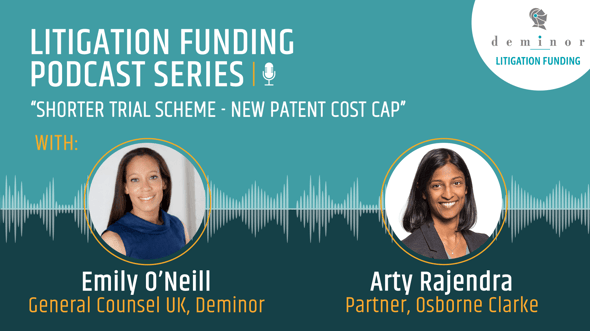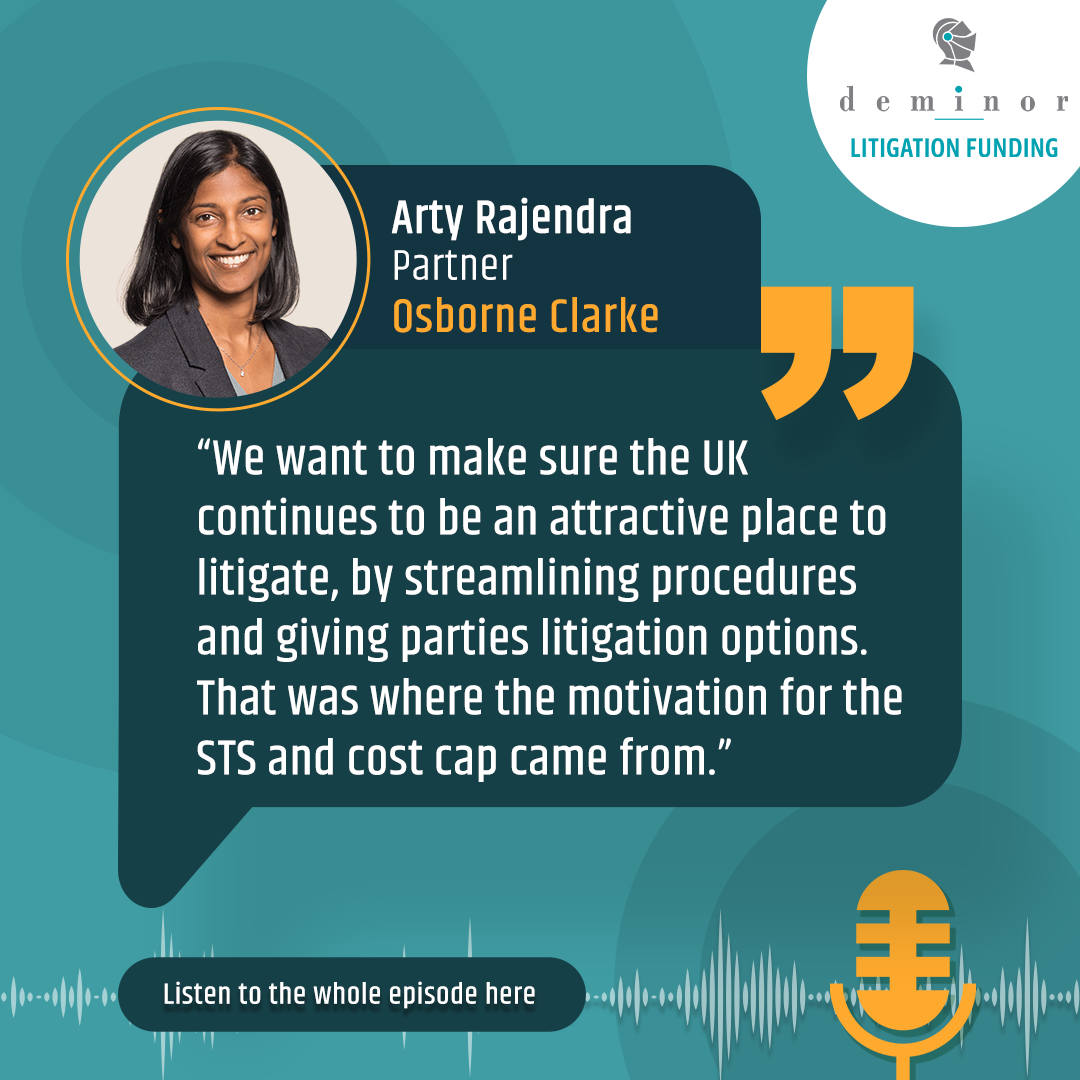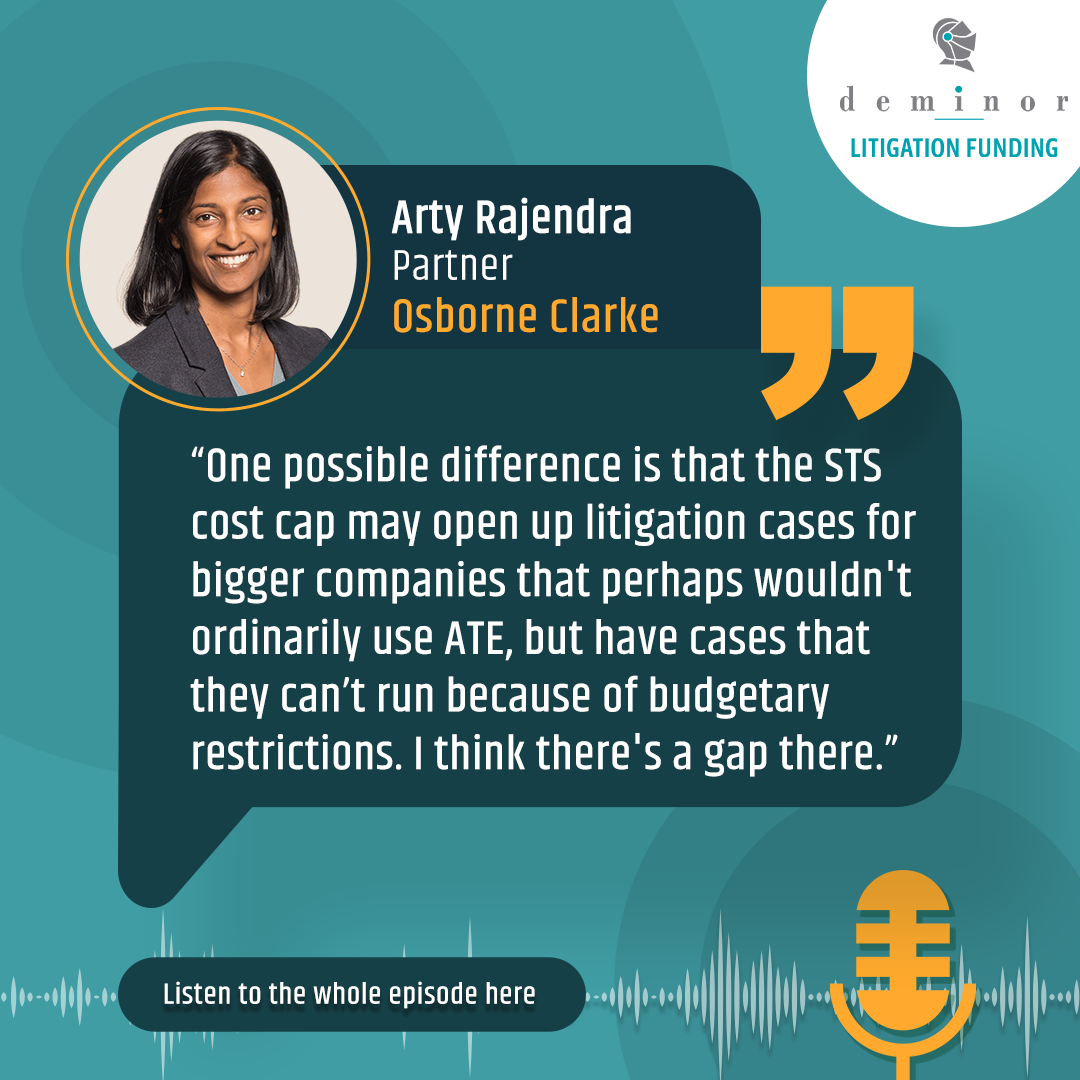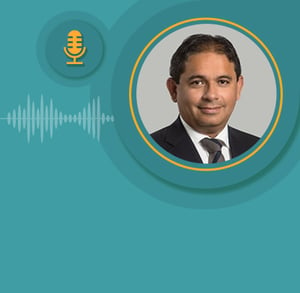In this podcast series, Emily O'Neill General Counsel UK for Deminor Litigation Funding, undertakes interviews with global professionals to discuss different aspects of litigation and litigation funding.
Deminor welcomes you to join this conversation as we summarise the key elements of the conversations between Emily O'Neill and these experts, as captured in the podcast transcripts below.
Podcast Preface:
Deminor General Counsel UK, Emily O'Neill (EON), speaks with Arty Rajendra (AR), Partner and Head of Intellectual Property (IP) Disputes at Osborne Clarke and Chair of the Intellectual Property Lawyers Association (IPLA).
In this interview with Emily O’Neill (EON), Arty explains what the Shorter Trials Scheme is, the opportunities it offers claimants and how a cost cap of £500,000 introduced at the start of 2024 will impact them.
Podcast Transcript:
EON – Can you summarise what the Shorter Trials Scheme (STS) is and which cases are suitable for litigating under the STS?
AR – It started off as a pilot scheme in 2015 and was part of two reforms designed to streamline litigation in the business and property courts: the STS and the Flexible Trials Scheme. Court of Appeal judge Colin Birss was one of the leading lights promoting it within the IP community.
The STS tries to get to a judgment quicker. After the three-year pilot scheme it is now permanent which means you should get a trial within twelve months of issuing a claim, perhaps even quicker. Certainly, you will have a trial within eight months following the first case management conference (CMC). The CMC is a very early hearing that happens in any action where the court looks at the claim and decides what kind of evidence is needed with contributions from the parties about how they see it going ahead.
Importantly, in the current climate, you will get judgment within six weeks of the trial. The only downside is that the trial has to be four days, including pre-reading. If pr- reading takes a day, that leaves only three days in court, which really limits the number of witnesses you can have. In some cases, it’s possible to make cuts to things like opening and closing submissions, but where you have several witnesses, the parties need the freedom to cross-examine them at the right pace, and three days may not be enough.
So far uptake of the STS has been reasonable and we're hoping the cost cap will improve uptake even further.
EON – The Intellectual Property Lawyers Association (IPLA) played a leading role in developing the new STS cost cap. As Chair of the IPLA can you explain the thinking behind the cost cap and why the IPLA pushed for it to be introduced?
AR – The IPLA acts as a centralised voice for law firms that have substantial IP practises in the UK. Our objectives are to lobby for change and improvements within IP practice.
Just to plug our work a little, the IPLA helped to drive the creation of the Intellectual Property Enterprise Court (IPEC). My predecessor as Chair, Michael Burdon, said we needed a different route to litigate IP rights in the UK. The Burdon Plan came up with a way to transform what used to be called the Patents County Court into what is now the IPEC. The IPLA also works in conjunction with Oxford University to help train young lawyers in IP. Together we developed the graduate IP diploma that they run.
We want to make sure the UK continues to be an attractive place to litigate, by streamlining procedures and giving parties litigation options. That was where the motivation for the STS and cost cap came from.
There was also an eye on what the Unified Patent Court (UPC) was providing and whether we could offer something in addition to the UPC that is a really attractive, quick and cost-effective forum, that is an alternative to the IPEC. Because the IPEC cost cap is really quite low, but not unlimited, which is what you get with most actions brought in the patents court.
EON – How can litigants take advantage of the STS and the cost cap? Is there a specific procedure at the start of their action they need to go through?
AR – The cost cap automatically applies to all patent cases because the memorably titled practice direction PD 51 ZD is now in force. It is currently a pilot scheme, so it's in force for the next three years. I would encourage parties and lawyers to use it, because if we don't we might lose it.
There is a £500,000 cost cap for a liability trial and a £250,000 cost cap for a damages inquiry. The aim is to lower costs of patent litigation and increase certainty for parties, so they know what their cost exposure is at the beginning of the case. The IPEC provides both of those, which is why it has been so successful. But this does it for slightly more complex cases.
EON – From a litigation funding point of view, IPEC doesn’t make economic sense because of the lower damages cap and the cost cap as against the legal costs a party incurs there. If the real world costs that the claimant is going to incur in litigating their case in the STS are significantly higher than the cap, do you think there is a risk it will disincentivise use of this scheme if they have a good case and would ordinarily get a good cost recovery proportionate to their actual spend?
AR – That's a really good question. If we step back a bit, the reason why the IPEC is different is that when the cost cap came in for IPEC, it wasn’t meant to cover the actual costs of the litigation. There might be some firms and parties that can do a case under the cost cap, but certainly not in my experience.
In the IPEC there's no real correlation between the actual spend of the parties and the cost cap. However, the STS cost cap is different. When the IPLA, in conjunction with the IPEC users committee, came up with the cost cap, we analysed the data from the STS which showed the cost judgements of patent cases were around £500,000. Not in all cases, but it seemed to be around the right number.
There will be cases that will be more expensive than that, particularly if there have been various interim applications and things like that. But you should be able to do a three-day trial for around £500,000. So hopefully it won't dissuade litigants from using it. But if it's not right, they can go directly to the patent court where there's an unlimited cost recovery, so there is still an alternative option. But we think there's an unmet need for cases that are between the IPEC and the patents court, that the STS with the costs cap will fulfil.

EON – The STS cost cap has initially focused on patents. But why exclude copyright and trademark cases from the pilot?
AR – I have a mixed practice. I do a lot of patents, but I try and keep my hand in on copyright and trademarks too. I would absolutely love for this cost cap to apply to those cases as well. There is even more of an unmet need for cases where parties don't want to expose themselves to the potentially enormous costs that you might get in an ordinary high court action.
But there are pragmatic reasons for limiting it to patent cases. We didn't have the data for other IP rights that we had for patent cases to enable us to land upon an appropriate number, and you want to take an evidence-based approach. If listeners have some evidence of cost judgments in other IP rights that have been litigated in the STS, please let me know! Also, because the patents court has a different set up and changes can be made quicker because there is a judge in charge and it's not ordinary business and property business, it was something that could be done reasonably quickly.
Although it has still taken a while. One of the first big meetings the IPLA had with the IP Bar and IP Federation to get everybody's input was pre pandemic. But we're here now and it's been probed and tested and interrogated, which is great.
EON – I'm familiar with parties taking after the event (ATE) insurance to mitigate adverse party cost risk, which is available for all kinds of cases in the different higher court tracks. Do you think that other mitigations will have an impact on the uptake of the STS with the cost cap? Or do you think it's just an additional tool?
AR –You're definitely the expert on ATE! I’d say they're not mutually exclusive. I think you could potentially do both – it’s all about access to justice and enabling people to fight cases that they want to fight. One possible difference is that the STS cost cap may open up litigation cases for bigger companies that perhaps wouldn't ordinarily use ATE, but have cases that they can’t run because of budgetary restrictions. I think there's a gap there.
There are also some issues with ATE premiums. I'm sure they can be managed, but obviously that's an additional cost that wouldn't apply for those that don't have that kind of insurance. Hopefully this cost cap provides another option to ATE, and people can use it to give them certainty and manage costs.
EON – You’re right. ATE premiums are still quite high because the market is still quite limited, although it is more open than it was. If you win and you've got ATE, you're likely to have to pay a deferred premium from the damages, which will be an additional cost of the litigation even in the event of success. So the two may not work together that well, because you may still have a portion to pay which would then come from the damages.
I’m also not sure how willing insurers would be to insure non-damages bearing litigation, such as injunction or any other kind of declaratory relief, because if they want to recover something from the back end, then there's going to need to be a back end otherwise there will need to be a larger upfront premium. If it’s all upfront, I’ve seen the costs are significant. It’s an additional budgetary item right at the start for the claimant.
EON – The adverse party cost regime is quite helpful in deterring less than meritorious cases. Do you think that having a cap is going to encourage more litigation based on weak patents to come to the English courts?
AR – That was definitely a factor in our original discussions and there was quite a strong resistance to it for that precise reason. But I think weighing everything in the balance, the view was it is still better than not having a cost cap at all. It's’ still quite a fair chunk of money the litigating party has to bear. The losing party has its own costs and is exposed to another cost risk. That’s a million plus exposure, which is not to be sniffed at. It was a concern, but overall, we still think this is the right course.
EON – How do you hope the cost cap pilot progresses this year?
AR – I’m going to repeat my plea for parties to use it! I've certainly had cases where clients have equivocated over whether to issue proceedings and they've had good cases, but the exposure is so massive if you lose it probably doesn't make sense. If we can encourage parties to use it and we can get some good data around recovery rates, it will give people more confidence in the pilot and, hopefully, make it permanent.
Litigation Funding Podcast Series - Next Steps and Further Information:
Thanks for joining Deminor's Litigation Funding Podcast Series as we dive deep into core topics in funding litigation.
Keep a lookout for our upcoming conversations as Deminor General Counsel UK, Emily O'Neill, speaks with several more experts to get their insights into different aspects of litigation funding.
If you would like to connect with either Emily or Arty on LinkedIn, please click on the links below:
Emily O’Neill – Deminor General Counsel UK and Global IP lead
Arty Rajendra – Partner and Head of Intellectual Property Disputes at Osborne Clarke
***
Further Reading:
- https://www.deminor.com/en/case-studies/co-funder-proposes-sharing-of-litigation-funding-risk-to-leverage-deminors-in-house-due-diligence-capability
- https://www.deminor.com/en/case-studies/financing-assertion-of-patents-protecting-manufacturing-processes
- https://www.deminor.com/en/case-studies/telecoms-patent-assertion-multi-jurisdictional-campaigns
- https://www.deminor.com/en/case-studies/canadian-innovative-start-up-preparing-for-a-david-v-goliath-litigation-funding-battle
- https://www.deminor.com/en/case-studies/whats-the-risk-assessing-the-risk-of-counter-assertion-by-the-defendant-in-patent-litigation
- https://www.deminor.com/en/case-studies/overstepping-the-mark-litigation-funding-trade-mark-infringement
- https://www.deminor.com/en/case-studies/lights-camera-action-recovering-damages-for-infringement-of-rights-in-a-short-film
- https://www.deminor.com/en/case-studies/recovering-damages-for-stolen-software-through-litigation-funding
- https://www.deminor.com/en/case-studies/funding-in-the-pharma-sector-/-investing-in-a-case-where-litigation-is-already-ongoing









